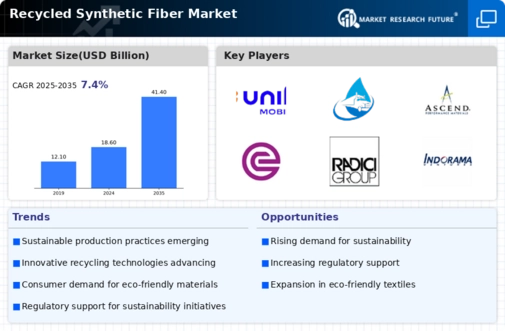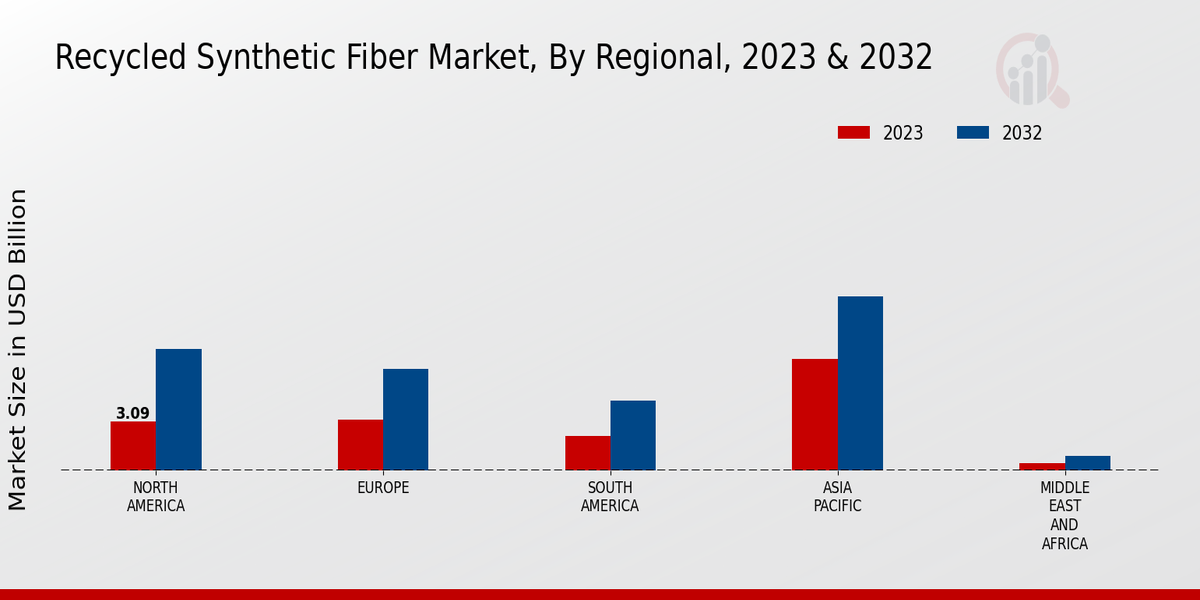Market Growth Projections
The Global Recycled Synthetic Fiber Market Industry is poised for substantial growth, with projections indicating a market value of 18.6 USD Billion in 2024 and an anticipated increase to 41.4 USD Billion by 2035. This growth trajectory suggests a compound annual growth rate of 7.55% from 2025 to 2035, driven by various factors such as increasing environmental awareness, regulatory support, and technological advancements. The market's expansion reflects a broader shift towards sustainability across industries, highlighting the importance of recycled materials in achieving environmental goals. As the demand for eco-friendly products continues to rise, the market is likely to experience robust development.
Growing Environmental Awareness
The increasing global consciousness regarding environmental sustainability drives the Global Recycled Synthetic Fiber Market Industry. Consumers and manufacturers alike are becoming more aware of the detrimental effects of plastic waste and synthetic fibers on ecosystems. This awareness has led to a surge in demand for recycled materials, as brands seek to enhance their sustainability profiles. For instance, major apparel companies are now incorporating recycled fibers into their products, contributing to the projected market value of 18.6 USD Billion in 2024. This trend is expected to continue, with the market potentially reaching 41.4 USD Billion by 2035, reflecting a growing commitment to eco-friendly practices.
Regulatory Support and Initiatives
Government regulations and initiatives aimed at reducing plastic waste significantly influence the Global Recycled Synthetic Fiber Market Industry. Various countries are implementing stricter regulations on single-use plastics and promoting recycling initiatives. For example, the European Union has set ambitious targets for recycling rates, which encourages manufacturers to adopt recycled materials in their production processes. This regulatory environment not only fosters innovation in recycling technologies but also enhances the market's growth potential. As a result, the industry is likely to witness a compound annual growth rate of 7.55% from 2025 to 2035, driven by supportive policies and incentives.
Rising Demand from the Fashion Industry
The fashion industry's shift towards sustainability is a significant driver of the Global Recycled Synthetic Fiber Market Industry. Brands are increasingly prioritizing the use of recycled materials to meet consumer expectations for environmentally responsible products. This trend is evident in the growing number of collections featuring recycled synthetic fibers, which appeal to eco-conscious consumers. As a result, the market is projected to achieve a value of 18.6 USD Billion in 2024, with expectations of further growth as sustainability becomes a core principle in fashion. The industry's commitment to reducing its carbon footprint is likely to sustain this momentum well into the future.
Increased Investment in Circular Economy
Investment in the circular economy is emerging as a crucial driver for the Global Recycled Synthetic Fiber Market Industry. Companies are recognizing the economic benefits of recycling and are increasingly investing in systems that promote the reuse of materials. This shift not only reduces waste but also creates new business opportunities within the recycling sector. As organizations align their strategies with circular economy principles, the demand for recycled synthetic fibers is expected to rise. The market's growth is indicative of this trend, with projections suggesting a compound annual growth rate of 7.55% from 2025 to 2035, reflecting the potential for sustainable economic development.
Technological Advancements in Recycling Processes
Innovations in recycling technologies are pivotal to the expansion of the Global Recycled Synthetic Fiber Market Industry. Advanced recycling methods, such as chemical recycling and enzymatic processes, are enhancing the efficiency and quality of recycled fibers. These technologies allow for the transformation of post-consumer plastics into high-quality synthetic fibers, which can be used in various applications, including textiles and automotive industries. As these technologies become more widely adopted, they are expected to improve the supply chain for recycled materials, thereby increasing market competitiveness. The anticipated growth trajectory suggests a robust market presence, potentially reaching 41.4 USD Billion by 2035.

























